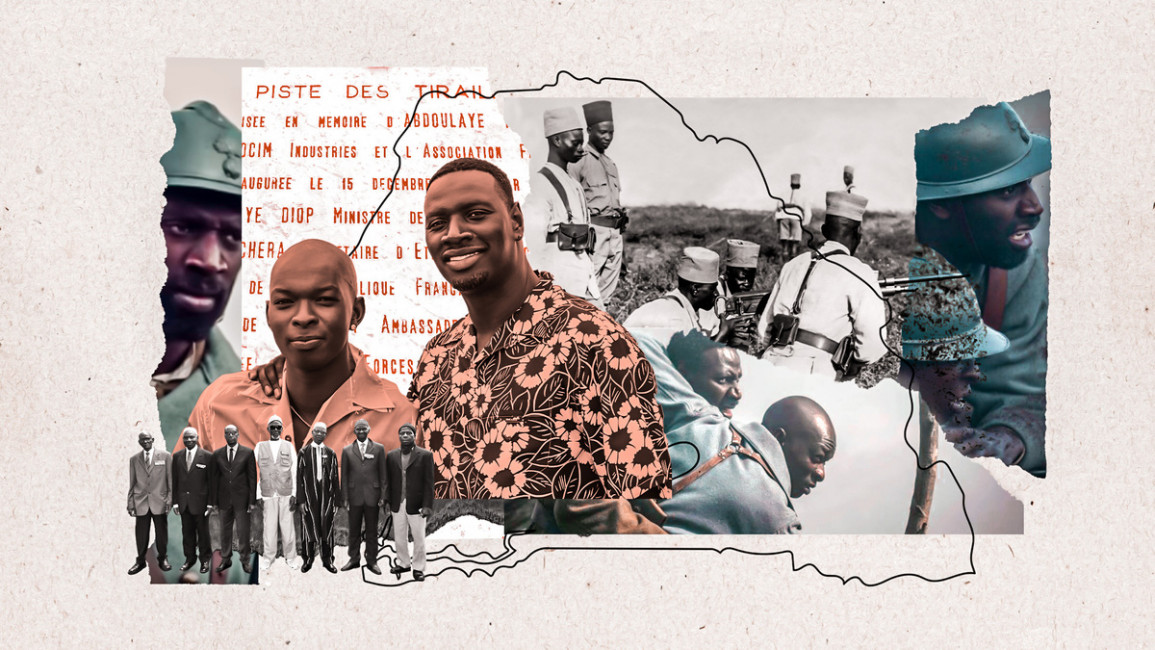
Tirailleurs: Never forget France’s debt to African soldiers
The recent release of Tirailleurs (Father and Soldier, 2022), a film featuring renowned French actor Omar Sy, which tells the story of Senegalese troops who has been enlisted by their French colonisers, has received much right-wing backlash.
Indeed the subject continues to be a gaping wound that the French state has long attempted to ignore.
This is perhaps unsurprising given that it wasn’t until Ousmane Sembène released his film Camp de Thiaroye in 1988, that anything was really known about one of the most brutal colonial repressions initiated by France after WWII: the Thiaroye massacre.
''Thiaroye demonstrated the outcomes of colonial greed and contempt for enlisted indigenous troops, despite their contribution in liberating French territories. For decades, France’s whitewashing of history meant that the massacre was ignored. It took until 2000, when the archives started to be opened for people to access, in order for some records to be set straight. However, justice has yet to be served.''
During the First and Second World Wars, France heavily relied on troops from across its empire. According to Dr. Pierre Journoud, researcher at the University of Paul Valéry in Montpellier, over 500,000 colonialized people were “recruited, willingly or by force” to take part in the various war activities for France. Between 200,000 fought between 1914-1918 and around 100,000 defended the French territory from between September 1939 and June 1940.”
The tirailleurs, Senegalese troops who had been on the frontline fighting against the Nazis, paid a heavy price both from German troop and France.
Internal reports during the period highlighted the terrible conditions in which the colonial troops were living throughout the Second World War. They were poorly fed, poorly clothed, and brutally repressed. Some had also spent years imprisoned in occupied France, until their repatriation from 1944 onwards.
Resistance
Following the end of the war, ships were loaded from France with these soldiers who were to be shipped to Senegal, but hundreds refused to go because their pensions had not been paid. The situation worsened. In response to “insubordination”, the colonial administration decided to group them all together in shacks with only straw as a mattress to rest on.
This was all despite the fact that ministerial letters at the time had explicitly indicated that pensions were to be paid to these troops in metropolitan France before they left the country and literally boarded the ships back to Senegal.
Additionally, in a letter unearthed by historian Armelle Mabon, the French military were reported to have shot colonial soldiers who refused to board the ship back to Senegal. The letter, written by a Senegalese soldier, described the way French soldiers ruthlessly shot them. Several tirailleurs were seriously injured, or even dead.
The letter also described the inhumane conditions they faced at the hands of French officers who threw them in a camp surrounded by barbed wire and given little to no food. The former soldier explained that before they suffered “at the hands of Germans”, then France made them “prisoners of war” once more.
The Circasia, the ship on which the former Senegalese war prisoners boarded, left the French town of Morlaix on 18 November 1944. In his December 1944 mission report, Dr Pelage detailed how It was the terrible conditions onboard from the get go that were said to have created the breeding ground for the events that transpired.
Following a stop in Cardiff, the tirailleurs were held again in a camp until the next departure. As the ship prepared to leave for Senegal, 400 of the soldiers refused to board in protest against the conditions. On 21 November 1944, 1300 tirailleurs arrived and were immediately transferred to French army barracks in the town of Thiaroye located 10 miles east of Dakar.
Rather than defusing anger by addressing demands of payments, French officers let the situation deteriorate.
When the French commander of the Senegal Mauritania division, General Dagnan, visited the region, his car was blocked by unhappy tirailleurs who were demanding the pensions they were owed. Once the general promised he would discuss the issue with his superiors, they let him go. However, Dagnan considered his experience with the former soldiers as a hostage situation and so ruthlessly retaliated.
The massacre
In the morning of December 1944, as the tirailleurs were still demonstrating against their ongoing plight, under Dagnan’s orders, 35 were killed, 35 were wounded, and 45 were jailed. Amongst those arrested, 34 were tried and sentenced to between one to ten years for taking part in what the French government called a ‘mutiny’.
This scale of brutality finds its roots in the colonial administration’s obsession with the obedience within its colonies, which continued well after WWII, from the massacre of “colonial soldiers” in Yên Bái to those committed in Madagascar, Algeria and Morocco.
According to the French, the four years spent in German prisons had “intoxicated” the African soldiers with “nationalistic propaganda” against France. In response to the events that took place in Thiaroye, the general governor of French West Africa sent a letter to the Minister of the colonies in which he clearly expressed the grave threat of such “propaganda” in undermining the French empire.
Indeed, Thiaroye demonstrated the outcomes of colonial greed and contempt for enlisted indigenous troops, despite their contribution in liberating French territories. For decades, France’s whitewashing of history meant that the massacre was ignored. It took until 2000, when the archives started to be opened for people to access, in order for some records to be set straight. However, justice has yet to be served.
Thiaroye massacre occurred when French soldiers killed Senegalese riflemen, who had fought in WW II for France.
— African Index (@africanindex_) May 26, 2021
They were killed for demanding allowances and pensions. Istead of being compensated, they were rounded up in front of self-propelled guns and murdered on Dec. 1, 1944 pic.twitter.com/xMGuBbWJGb
Not a single French officer was even reprimanded for ordering the killing and imprisonment of the Senegalese soldiers, nor has the French government ever honoured France’s debt towards the colonial troops.
These demands are unlikely to be met until adequate pressure reinforced by historians’ efforts, is placed on the former colonial power.
Film has clearly been a powerful tool in bringing the subject to the fore of French political discourse, and it is this that movements seeking to honour those killed, should capitalise on.
Indeed, despite the backlash from the French right, the expected success of Tirailleurs (2022) has already meant the horrific chapter in history can no longer continue to be buried. Furthermore, it is clearly already making an impact since the French government has since decided – over half a century later and as the majority of former soldiers are no longer with us – to allow the tirailleurs to live out their retirement in Senegal as they wished, and not in France.
Previously, then President Jacques Chirac accepted to pay the pensions owed to North African soldiers only following the film Indigènes (2006) was released. Clearly, France only acknowledges its freedom debt towards Africans when it is named and shamed, so let us continue applying pressure in this way.
Yasser Louati is a French political analyst and head of the Committee for Justice & Liberties (CJL). He hosts a hit podcast called "Le Breakdown with Yasser Louati" in English and "Les Idées Libres" in French.
Follow him on Twitter: @yasserlouati
Have questions or comments? Email us at: editorial-english@newarab.com
Opinions expressed in this article remain those of the author and do not necessarily represent those of The New Arab, its editorial board or staff.



